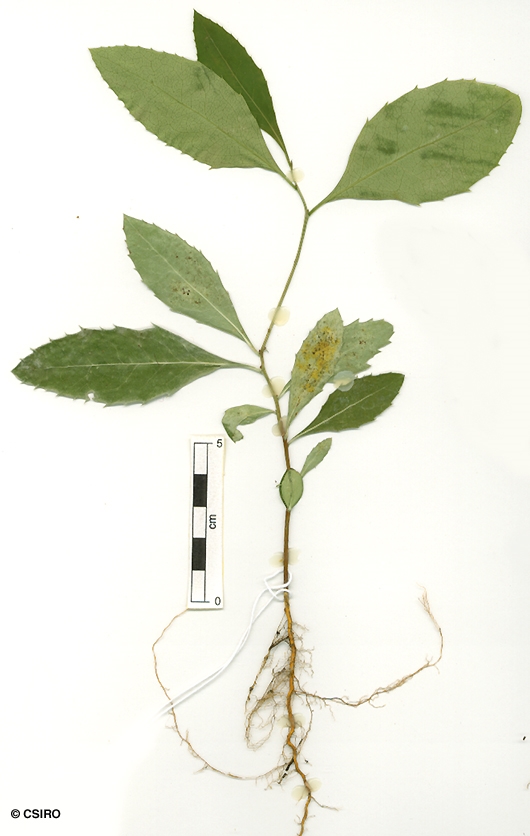Australian Tropical Rainforest Plants - Online edition
Denhamia bilocularis (F.Muell.) M.P.Simmons




McKenna, M.J., Simmons, M.P., Bacon, C.D. & Lombardi, J.A. (2011) Systematic Botany 36(4): 929.
Orangebark
Shrub or small tree to 10 m tall. Inner bark orange or orange-brown. Stems hairless with fine longitudinal ridges.
New growth often reddish, twig bark orange when scraped gently with a knife. Leaves simple, alternate. Stipules 2, free, lanceolate, usually 0.5-2 mm long. Petiole 2-7 mm long, articulation visible where petiole attaches to stem. Leaf blade elliptic to narrow-elliptic, oblong, 3-11 cm long, 1.5-7 cm wide, base cuneate or attenuate, margins toothed, apex acute, acuminate or rarely obtuse. Lateral veins 5-8 pairs. Surfaces hairless. Midrib raised on the upper surface. Lateral veins forming loops inside the blade margin. Twigs angled or longitudinally ribbed.
Inflorescence axillary, racemose. Pedicels 1.8-2.5 mm long. Flowers bisexual, actinomorphic, 4 or 5 merous. Sepals ± free, broadly ovate, c. 0.8 mm long. Petals free, oblong-ovate, 1.5-2.5 mm long, white to cream. Stamens inserted beneath disc, alternating with petals, anther filaments about 0.8-2 mm long, anthers globose, small. Disc prominent, about 1.2 mm diam.; ovary superior, 2(-4) locular; style elongate, stigma ± 2-lobed.
Fruit a capsule, 2 valved, globular or obovoid, ellipsoid or obcordate, 5-8 mm long, 4-7 mm diam., style persistent at apex, yellow. Seeds 1 or 2, black or brown, ellipsoid, 4 x 3 mm; aril thinly fleshy, smooth, orange, completely or partly covering seed. Embryo green. Cotyledons about 2.5 x 2 mm, radicle about 0.6 mm long.
Seed germination time 45 days. Seedling glabrous. Cotyledons elliptical, about 13 x 7-9 mm. Hypocotyl 4-angled, square in transverse section. First leaves oblanceolate, apex mucronate, base attenuate. Leaf blade margins toothed with 3-7 teeth on each side particularly towards the apex. Midrib raised on the upper surface. At the tenth leaf stage: leaf blades elliptic, apex apiculate, base attenuate, margins with 10-16 serrate teeth on each side. Midrib raised on the upper surface. Stipules lanceolate, about 1 mm long, base lacinate with an extension or lobe pointing backwards. Stems 4-5-angled with lines running down from the decurrent leaf bases. Roots orange.
Occurs in NEQ, CEQ, and southwards to north eastern NSW. Grows in dry rainforest, vine thickets and open forest.
This profile information and associated coding has been adapted from Hyland (2010); Cooper & Cooper (2004), McKenna et al. (2011), Simmons (2004) and Harden et al. (2014).
Maytenus bilocularis (F.Muell.) Loes., Die Naturlichen Pflanzenfamilien Edn. 2, 20 b: 135 (1942). Celastrus bilocularis F.Muell., Transactions of the Philosophical Institute of Victoria 3: 31 (1859), Type: "On the shrubby banks of the rivers Dawson and Burnett.". Maytenus sp. Windsor Tableland (B.Hyland 3416RFK).





